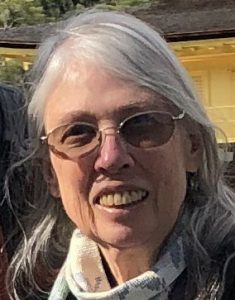 NAME: Bonnie Inouye
NAME: Bonnie Inouye
BACKSTORY: Bonnie Inouye’s book Exploring Multishaft Design (currently out of print) has for many weavers been the way into much more exciting cloth and learning many different techniques. I met Bonnie through Complex Weavers and her many articles in Handwoven and the Best of Weavers publications, her posts on WeaveTech and her book. It was hugely influential to me and I’m really glad to say that Bonnie is working on an updated 2nd edition right now! Bonnie was particularly influential to me through her workshop Feel the Flow. Wendy Morris and I took an experimental online class with Bonnie and delved deep into textural weaving which is a rabbit hole I am still following! Bonnie’s influence on contemporary weavers is undoubted. Here’s her path into weaving!
HOW I GOT INTO WEAVING
As a child, I wove potholders and learned to knit and sew. I found embroidery stitches in books and developed a style with entwined flowers for my “peasant” blouses which I wore with full skirts for my International Folk Dance groups. Favorite skirts for dancing had woven borders.
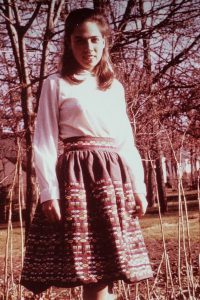 In 1965, I left home for Swarthmore College where I taught folk dancing while studying Art History and Mathematics. I noticed that the woven borders on 4 of my skirts had design elements in common, even though they came from 4 different countries. One was from Canada, one from Malta (in the photograph), one from Guatemala and I think the last was from Sweden. The colors were different but the patterns had a similarity that I figured had come from the way they were produced. I wondered if I could make something more complex than a frame with pegs that could form geometric designs. I was given two wooden grape boxes and placed one inside the end of the other to form an L shape. I added a row of nails to hold the warp and braced the boxes for tension. I made 2 levels of loops with wire which carried knitting yarn, sort of like a not-rigid heddle. This let me produce a shed and I could make new patterns by twisting the wire to change which warps were raised. I learned that wire can be twisted back and forth a finite number of times before it breaks in two! And those handwoven skirt borders were all 4-block designs. It was December 1967 and I wove a long strip of patterns on my grape-box loom and sewed pieces together for a cushion for my mother. Then I asked Mom if she knew anybody with a floor loom and we went to see some looms in a studio. I took notes. My father had a woodworking room and provided me with boards cut to appropriate sizes. I already had a used reed from a friend and that determined the width of my first floor loom. I flew back to school with a duffle bag full of pieces and a sturdy board with 4 big nails so I could tie string heddles on the airplane. (Imagine doing this now!)
In 1965, I left home for Swarthmore College where I taught folk dancing while studying Art History and Mathematics. I noticed that the woven borders on 4 of my skirts had design elements in common, even though they came from 4 different countries. One was from Canada, one from Malta (in the photograph), one from Guatemala and I think the last was from Sweden. The colors were different but the patterns had a similarity that I figured had come from the way they were produced. I wondered if I could make something more complex than a frame with pegs that could form geometric designs. I was given two wooden grape boxes and placed one inside the end of the other to form an L shape. I added a row of nails to hold the warp and braced the boxes for tension. I made 2 levels of loops with wire which carried knitting yarn, sort of like a not-rigid heddle. This let me produce a shed and I could make new patterns by twisting the wire to change which warps were raised. I learned that wire can be twisted back and forth a finite number of times before it breaks in two! And those handwoven skirt borders were all 4-block designs. It was December 1967 and I wove a long strip of patterns on my grape-box loom and sewed pieces together for a cushion for my mother. Then I asked Mom if she knew anybody with a floor loom and we went to see some looms in a studio. I took notes. My father had a woodworking room and provided me with boards cut to appropriate sizes. I already had a used reed from a friend and that determined the width of my first floor loom. I flew back to school with a duffle bag full of pieces and a sturdy board with 4 big nails so I could tie string heddles on the airplane. (Imagine doing this now!)
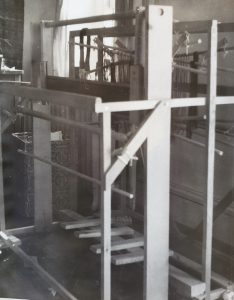 To make 4-block designs, I needed a 4-shaft loom. I assembled my loom in my dorm room and made it work! I found a used weaving book by Marguerite Porter Davison, who lived in Swarthmore. The drafts showed me how patterns are formed by threads on looms. Weaving is a place where art and mathematics work together! I tried a couple of patterns from the book, changing the treadling to see what happened. I made drafts on graph paper. It was all so enticing! My floor loom had a few problems and in 1970 I gave it to a friend and bought a LeClerc Artisat loom for under $200, making the money by sewing and embroidering wedding clothes for friends.
To make 4-block designs, I needed a 4-shaft loom. I assembled my loom in my dorm room and made it work! I found a used weaving book by Marguerite Porter Davison, who lived in Swarthmore. The drafts showed me how patterns are formed by threads on looms. Weaving is a place where art and mathematics work together! I tried a couple of patterns from the book, changing the treadling to see what happened. I made drafts on graph paper. It was all so enticing! My floor loom had a few problems and in 1970 I gave it to a friend and bought a LeClerc Artisat loom for under $200, making the money by sewing and embroidering wedding clothes for friends.
I took an education class at Swarthmore, student-teaching elementary school art. I encouraged the children to experiment with art and crafts. Coloring books are fun, but you can create your own wonderful pictures! Within a few years, I was teaching spinning and natural dyes and basic 4-shaft weaving to adults and I still encourage weavers to have fun creating new drafts.
I have always been interested in the way designs are made with shaft looms. I like functional cloth. Many weave structures appeal to me. I look for advantages and drawbacks in each new structure. I enjoy weaving organic shapes and curves, images and geometric designs, flat cloth and textures. Good weaving software helps me to make new designs and understand new structures. Now I use looms with 16 and 24 shafts and prefer large-scale or non-repeating designs. Recent work includes turned polychrome tied weaves, parallel threadings and interleaved designs in warp and/or weft.
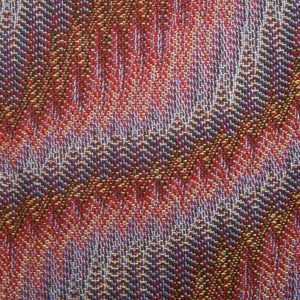
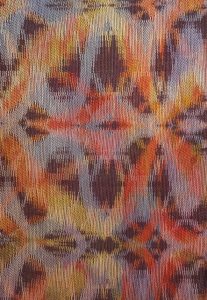
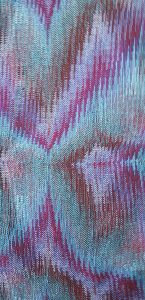
I joined Complex Weavers in 1987 when I went from 4 shafts to 16. Since 1988, I have attended CW Seminars, teaching for many.
I look forward to announcing Bonnie’s book when she has published it. In the meantime, you can see a full list of her publications and descriptions of seminar and workshop topics on her website although now she only occasionally teaches. She has four wonderful grandchildren and lives with her husband in western Colorado.
Website : www.bonnieinouye.com
NEXT TIME: Jennie Parry

Your point of view caught my eye and was very interesting. Thanks. I have a question for you.
Just signed up on Jilibetloginregister. The process was smooth, thankfully! Let’s hope I win some real money here, man! Check it out yourself: jilibetloginregister